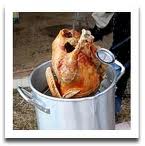 Are you curious about deep frying a turkey? I know you are! You’ve heard all the talk about how tasty they are; tender and juicy yet crispy on the outside. You’ve seen the turkey fryers and giant jugs of peanut oil. But you’re a little nervous. That’s a lot of hot oil! USDA’s Food Safety & Inspection Service has these tips to help you safely prepare a deep fat fried turkey.
Are you curious about deep frying a turkey? I know you are! You’ve heard all the talk about how tasty they are; tender and juicy yet crispy on the outside. You’ve seen the turkey fryers and giant jugs of peanut oil. But you’re a little nervous. That’s a lot of hot oil! USDA’s Food Safety & Inspection Service has these tips to help you safely prepare a deep fat fried turkey.
Planning: Tips for Purchasing a Turkey
Before you purchase your turkey, check the instructions for your turkey fryer. Most fryers will accommodate a 12-16 lb. turkey. A larger turkey will not fit in the fryer and will take too long to cook. Don’t stuff a turkey that you’re going to fry!
Before you unwrap the turkey, take a minute to determine the amount of oil needed. Place the turkey in the fryer and add enough water to cover it. Do not fill the pot more than ¾ full; the oil level should be three inches to five inches from the top of the fryer. The turkey should be covered by about one to two inches. Remove the turkey and measure the amount of water – that’s how much oil you’ll need. Drain or pour out the water and dry the pot thoroughly.
Preparation: Check Your Food Safety Steps
As you prepare the bird, separate the raw turkey from fresh foods on your menu, and use separate cutting boards, plates, and utensils to avoid cross contamination. If your turkey is frozen, make sure to thaw it before frying. You can thaw it in the refrigerator. It takes about 24 hours for every four to five pounds. Keep it refrigerated until about 30 minutes before cooking.
If you choose to marinade or to inject a flavor into the turkey, allow it to stand in the refrigerator for 24 to 48 hours before cooking. And always keep hands, utensils, and surfaces clean.
 Cooking: Caution! Hot Oil!
Cooking: Caution! Hot Oil!
Deep fat frying a turkey must be done OUTSIDE! Select a safe, flat outdoor location that is well-lit, well-ventilated and away from trees, shrubbery and buildings. Heat the cooking oil to 350°F. Before lowering the turkey into the oil, turn the burner off. Do not just dunk the turkey in the oil. To avoid the oil bubbling over, gradually lower the turkey into the hot oil, pull it back out, and repeat until it is fully immersed. Turn the burner back on and bring the oil back to 350°F.
Monitor the temperature of the oil with a thermometer constantly during cooking. Never leave the hot oil unattended! Allow about three to five minutes per pound cooking time. When the time is up, turn the burner off, and slowly lift the turkey out of the oil. Hold it over the fryer so the oil can drain. Check the temperature of the turkey with a food thermometer. The turkey is safely cooked when the food thermometer reaches a minimum internal temperature of 165°F in the innermost part of the thigh and wing and the thickest part of the breast.
Enjoy Your Meal
Cover the bird with foil and let it rest about 20 minutes before carving. After serving, refrigerate the leftovers within two hours in shallow containers. Refrigerate and use turkey leftovers for three to four days or freeze for three to four months.
Don’t forget about the oil! Once the turkey is out, remove the pot from the burner and move to a flat, safe place and allow the oil to cool, covered, overnight. Once the oil has cooled you can strain out the solids and use it again. Store in a cool, dry place for up to six months.
If you have more questions call the Meat & Poultry Hotline toll-free at 1-888-674-6854. The Hotline will be staffed from 8 a.m. to 2 p.m. Eastern Time on Thanksgiving. Bon Appetite!
Source: USDA
Day. You can also ask a question in English or Spanish at AskKaren.gov, available 24 hours a day

Comments